 |
6.1 Command group CAMERA |
The commands in the CAMERA command group are used for setting the readout format and the exposure times, generating the flatfields and doing the exposures. There are three ways to get one or more exposures:
There are several ways to change the exposure time. The simplest way is to type the desired exposure time into the corresponding edit field. Another possibility is to increase/decrease the exposure time using the spin control ( here sophisticated steps to increment/decrement the exposure time are used ). The third way to change the exposure time is to use the << and >> buttons. Here the next pseudo logarithmic value is selected, i.e. those buttons will select the exposure times 1, 2, 5, 10, 20, 50, 100, 200, 500, 1000, etc. ms.
 |
Once the settings for the readout format and the exposure time are done, just use ![]() to acquire a single image.
The data are stored in an array IMAGE(n), where n is the actual image number, that is visible as title of the 'IMAGE n' section of the 'EMMENU' mainpage
(see figure above).
to acquire a single image.
The data are stored in an array IMAGE(n), where n is the actual image number, that is visible as title of the 'IMAGE n' section of the 'EMMENU' mainpage
(see figure above).
A click on ![]() opens the double exposure popup menu:
opens the double exposure popup menu:
Select the top entry to start the double exposure. The name in parentheses indicates the macro that is executed between the 1st and the 2nd exposure.
Choose Select and edit macro to receive the following dialog:
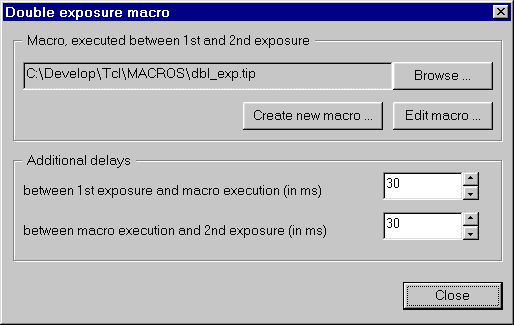 |
Here you can browse for/create or edit the macro that is executed between the two exposures of the double exposure. It is up to the user to select and/or create an appropriate macro. ( E.g. TEM image shift, gonio move, etc. ). Here you can also define additional delays. One delay is performed before the macro execution, the other after the macro execution. The intension is to give the shutter time to open, to wait for stabilized conditions, to .... .
The 'Continuous' dialog is opened with ![]() . Various modes for a continuous readout of the slowscan CCD camera are available.
. Various modes for a continuous readout of the slowscan CCD camera are available.
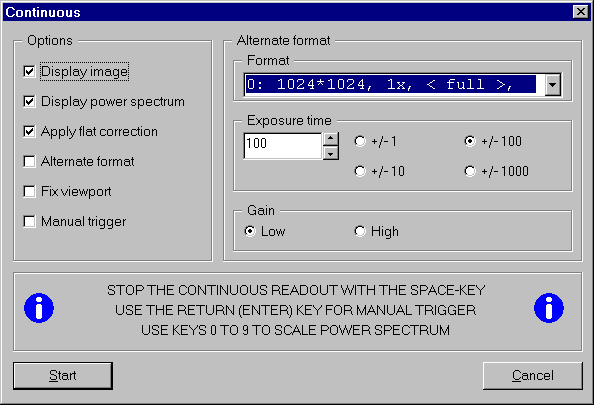 |
| Options: | |
|---|---|
| Display image | Each image taken from the camera is shown on the display. If the flatfield option is selected too, the corrected image is displayed. |
| Display power spectrum | The power spectra from the recorded images are calculated and displayed. If the flatfield option is selected too, the power spectra from the corrected data are calculated. |
| Apply flat correction | Apply flatfield correction to the image data. |
| Alternate format | Use the alternate format/time/gain instead of the current format/time/gain. Note: the current settings for format/time/gain are not changed. |
| Fix viewport | The images and the power spectra are displayed at fix viewports instead of incrementing the viewport numbers automatically. |
| Manual trigger | If this option is selected an image is taken when you press the <RETURN> or the <ENTER> key. |
| Alternate format: | |
|---|---|
| Format | |
| Exposure time | The alternate exposure time is selected in the same way as in Exposure time. |
| Gain | Either 'Low' or 'High'. |
With  the continuous readout begins. It is stopped with the <SPACE> key on the keyboard. You can change the scaling of the powerspectra with the number keys <0> to <9> while the continuous readout works.
the continuous readout begins. It is stopped with the <SPACE> key on the keyboard. You can change the scaling of the powerspectra with the number keys <0> to <9> while the continuous readout works.
Clicking on ![]() opens the 'Series' dialog, which is used for the acquisition and analysis of whole image series.
opens the 'Series' dialog, which is used for the acquisition and analysis of whole image series.
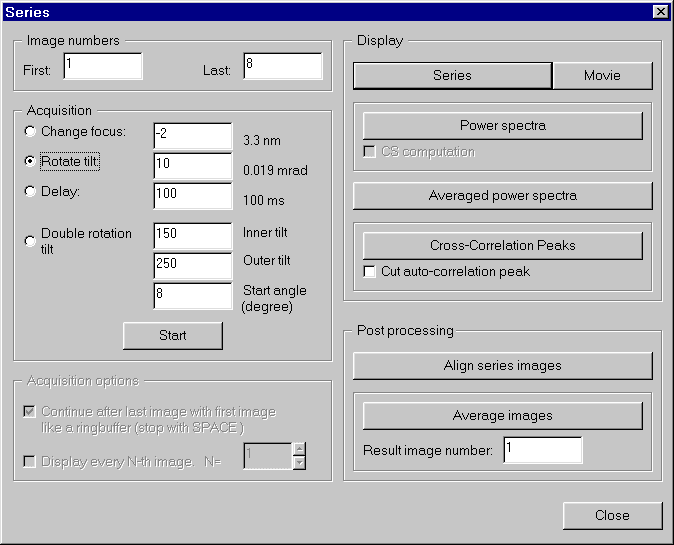 |
The 'Series' dialog is divided into 5 sections:
In the section 'Image numbers' you have to select the first and the last image number of the series you want to acquire/display/align/average.
In the 'Acquisition' section you can select whether you want to acquire a focus series, a tilt series, a time delay series or a double rotation tilt series. Besides that you have to enter the corresponding parameter right to your selection. The focus change / tilt change or the delay will take place after each exposure of the series. The double rotation tilt first takes 4 images at the inner tiltangle and then 12 images at the outer tiltangle. The series begins with the given startangle.
In all cases the initial values are restored after the series acquisition.
With ![]() the series acquisition begins. Stop the acquisition with the <SPACE> key at the keyboard.
the series acquisition begins. Stop the acquisition with the <SPACE> key at the keyboard.
 |
If the acquisition mode Delay is selected, the section 'Acquisition options' is enabled. In this mode there are 2 more options available. Check 'Continue after last image with first image...'
if you wish that the data is stored in the image series defined by first image and last image like in a ring buffer. I.e. if the last image of the series is acquired, the series acquisition
does not stop, but continues to acquire images. The images are written over the already acquired images from the beginning without any warning, so that they are lost. This acquisition continues until the space key is
pressed.
Since the series acquisition is intended to acquire images with high speed, none of the images is displayed during an acquisition. If however the ringbuffer option is used, you might want to have a look
at some of the images during acquisition to see if a certain event already occured. To do so, check the option 'Display every N-th image' and select an appropriate value for N. Now every Nth
image is displayed. Note: Due to the effect that the scaling of the image and the displaying takes time, the time intervals between acquired images are no more equidistant.
In the 'Display' section you have several ways how to display the image series data.

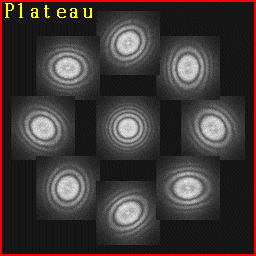
In the 'Post processing' section there are two buttons to align or average image data.
The 'Camera format' dialog is started with ![]() . Here you can select the camera readout format, exposure mode, gain, readout speed, the shutter and whether flatfield correction is applied or not.
. Here you can select the camera readout format, exposure mode, gain, readout speed, the shutter and whether flatfield correction is applied or not.
 |
The 'Camera format' dialog has six sections:
In the section 'Camera' you can select one of maximal two available cameras listed there.
In the section 'Format' you can select one of ten different formats which are listed there. If the size(x/y) changes, all the memory will be rearranged, i.e. all data in memory are lost (you will be warned before you leave the page). The size(x/y) column shows how many pixels (binned or not) are actually read into the memory, e.g. for a camera with maximal 1024x1024 pixels both formats 512/binning=1/center and 512/binning=2/full will deliver an image with 512x512 pixels, whereas 1024/binning=1/full and 512/binning=2/full will show the same image contents, but the first with 1024x1024 pixels and the second with 512x512 pixels. The column Area defines whether the data is acquired from the whole chip area (full), of the center of the chip area (center) or any area (any). The column number shows how many images of those formats are available ( memory dependent ). To change the available formats, you have to change the configuration file for the camera settings (see also Frequently Asked Questions (FAQ) section EMMENU).
In the section 'Exposure mode' you can select one of the four exposure modes:
'normal' will take a normal exposure with the selected exposure time and is generally default.
'dark image' will acquire dark image with the selected exposure time.
'normal + dark' will acquire first a dark exposure and immediately after that a normal image, both with the selected exposure time.
'bias image' will acquire a bias image (= dark image with exposure time = zero).
In the section 'Gain' you can select the gain mode with the spin controls ![]() and
and ![]() .
.
In the section 'Readout speed' you can select the camera readout speed number using the spin controls ![]() and
and ![]() .
.
In the section 'Shutter' you can select the shutter for image acquisition:
'exposure' uses the exposure shutter of the TEM
'beam blanker' uses the TEM's beam blanker.
In the section 'Options' you can select whether an automatic flat correction will be performed after an exposure in 'normal' or 'normal + dark' mode. This option is only selectable if flatfields for the desired format + gain setting + speed + shutter mode are available.
If the option Auto increment is selected, the image number is automatically increased before each exposure until the last image is reached. If the last image is reached,
a dialog will open and ask how to proceed: Continue with image 1 or stop auto increment.
Note: you have to create flatfields for each combination you want to use.
The 'Create flatfield' dialog is opened with ![]() .
.
CCD cameras are strongly linear within a wide dynamic range. Therefore inhomogenities of the phosphor screen and transmission of the fiber optics are clearly visible specially in the power spectra. This can be removed with the flatfields command using a dark image and a homogeneous illuminated image (flatfields). These images must be created for each camera format, subarea, binning factor, gain and readout speed individually.
 |
In the section 'Current format' is the actual camera format displayed.
In the section 'Exposure time in ms' you can change the exposure time. The default value is taken from the main dialog.
The 'Adjustment' section:
This section is used to prepare the system for generating flatfields.
With a click on the  button
a continuous readout of the camera
is started (stop it with the <SPACE> key). The image, its maximum and mean value are displayed on the screen.
The illumination should be adjusted such that the mean value is less than the half range of the dynamic range of the camera.
E.g. about 2048 for 12-bit (-> max. 4095) cameras. Ensure that there is no overflow in the image data.
button
a continuous readout of the camera
is started (stop it with the <SPACE> key). The image, its maximum and mean value are displayed on the screen.
The illumination should be adjusted such that the mean value is less than the half range of the dynamic range of the camera.
E.g. about 2048 for 12-bit (-> max. 4095) cameras. Ensure that there is no overflow in the image data.
Pushing the ![]() button takes an image without flatfield correction. The image, its maximum and mean value are displayed on the screen.
button takes an image without flatfield correction. The image, its maximum and mean value are displayed on the screen.
In the 'Acquisition' section the flatfield is created with ![]() . First the desired number of dark images is acquired, then the dark images are averaged and stored. After that the desired number of flat images are acquired and averaged. Using both the averaged dark data and the averaged flat data the flatfield correction data are calculated.
. First the desired number of dark images is acquired, then the dark images are averaged and stored. After that the desired number of flat images are acquired and averaged. Using both the averaged dark data and the averaged flat data the flatfield correction data are calculated.
The desired number of exposures is set in the 'Exposures' field.
Hint 1: more images will reduce the influence of noise, but it takes even more time to create the flatfields.
Hint 2: the number of exposures is a power of 2 out of the interval [1, 128].
If the option Create only new darkfields is checked, only new dark fields ( i.e. no flat images ) are acquired.
The options Remove hot pixels in dark images and Remove hot pixels in flat images then the acquired images are checked for hot pixels. Those hot pixels are replaced by the mean of the neighbours.
'Check and save' section:
![]() Display the calculated darkfield.
Display the calculated darkfield.
![]() Display the calculated flatfield.
Display the calculated flatfield.
![]() Display a corrected exposure. Note: you must generate the flatfield before you correct any data.
Display a corrected exposure. Note: you must generate the flatfield before you correct any data.
![]() Calculate and display the powerspectrum of the last exposure.
Calculate and display the powerspectrum of the last exposure.
![]() Store the acquired dark and flat data in a file.
By default flat data will be stored in the directory ...\tcl\emmenu\tem1000, whereas '...' means the directory-path to tcl root directory.
Store the acquired dark and flat data in a file.
By default flat data will be stored in the directory ...\tcl\emmenu\tem1000, whereas '...' means the directory-path to tcl root directory.
A click on button ![]() will open a dialog box that prompts for a safety check whether this flatfield is really to be deleted.
will open a dialog box that prompts for a safety check whether this flatfield is really to be deleted.
Yes to all deletes all flatfields without further prompting,
No to all terminates the deleting of flatfields,
Yes deletes this flatfield and prompts again for the next one and
No does not delete this single flatfield and prompts again for the next one.
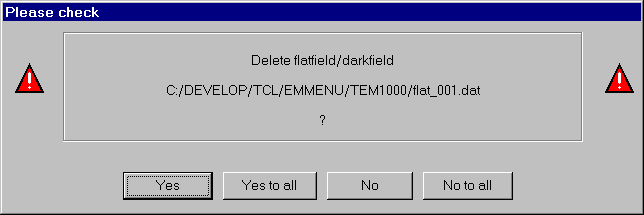 |
Hint: How to acquire flat correction data:
 |
 |
| Uncorrected image with homogenious illumination Note the "chicken wire" |
The corresponding power spectrum. |
 |
| A flatfield image Note, that it is inverted in EMMENU, if the camera dynamic is 12bit ( or less ). |
Last update: